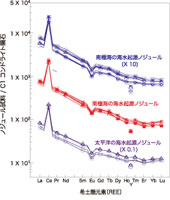Top page > Geochemistry & Cosmochemistry Group
Geochemistry & Cosmochemistry Laboratory




The Geochemistry & Cosmochemistry Laboratory (GCL) of Nagoya University analyses chemical and isotopic compositions of
natural samples with the aim of understanding the environment of the Earth on a global scale including human interaction.
The following three themes are the principal pillars of our research and education: 1) Cosmochemistry, 2) Geochemistry, and
3) Environmental Geochemistry.
Summary of research themes

Rare Earth Element Geochemistry
Rare Earth Elements (REE) form a unique element group
characterized both by similarities and differences largely due to the electronic configuration of [Xe](4fq) for the REE(Ⅲ) series. The REE group can be used as a chemical tracer to identify the reactions that are occurring in natural systems. In our research we focus on REE abundances of natural materials taking into account the quantum-chemical effect of 4f electrons with different anions or anionic groups (the lanthanide tetrad effect). Examples are REE studies of deep-sea Mn nodules, limestone, sedimentary and igneous rocks, and relevant experimental systems.

Environmental Geochemistry
Chemical analyses and geochemical discussions of natural samples are indispensable for environmental assessment. We are engaged in assessment of “inland seas” by means of chemical analyses of bottom sediments, seawater, macro-algae and bivalves and in “atmospheric pollution in Ulaanbaatar, Mongolia” by means of SEM observations, and ICP-MS, CHNS and EDS analyses of particulate materials.

High dispersion spectroscopic observation in space
and laboratory
Spectroscopic observation is ideally suited to studying short-lived molecules that exist in the planetary atmospheres and the interstellar medium (ISM). We have developed an immersion grating mid-infrared cryogenic spectrograph for astronomical telescopes, aiming to detect as yet unrecognized interstellar molecules. We are also carrying out laboratory studies of the infrared spectroscopy of short-lived molecular species that may exist in the ISM utilizing a range of techniques for high-sensitive and high-dispersion observation.

Organic Cosmochemistry
The three main themes of my reseach are: 1. the thermal
stability of organic materials in rocks, 2. the formation process of organics in meteorites, and 3. the morphology of microfossils in Archean cherts.

Radiogenic Isotope Geochemistry
The radiogenic isotope tracers such as 87Sr, 143Nd and 176Hf are powerful tools for carrying out paleoenvironmental reconstruction. These data sets also form the basis evaluating ideas of how the climate will change in the future.

















